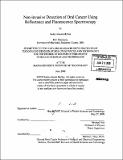| dc.contributor.advisor | Michael Feld. | en_US |
| dc.contributor.author | McGee, Sasha Alanda | en_US |
| dc.contributor.other | Harvard University--MIT Division of Health Sciences and Technology. | en_US |
| dc.date.accessioned | 2008-12-11T18:42:33Z | |
| dc.date.available | 2008-12-11T18:42:33Z | |
| dc.date.copyright | 2008 | en_US |
| dc.date.issued | 2008 | en_US |
| dc.identifier.uri | http://hdl.handle.net/1721.1/43869 | |
| dc.description | Thesis (Ph. D.)--Harvard-MIT Division of Health Sciences and Technology, 2008. | en_US |
| dc.description | Includes bibliographical references. | en_US |
| dc.description.abstract | In vivo reflectance and fluorescence spectra were collected from patients with oral lesions, as well as healthy volunteers, in order to evaluate the potential of spectroscopy to serve as a non-invasive tool for the detection oral cancer. A total of 710 spectra were analyzed from 79 healthy volunteers, and 87 spectra from 67 patients. Physical models were applied to the measured spectral data in order to extract quantitative parameters relating to the structural and biochemical properties of the tissue. Data collected from healthy volunteers were used to characterize the relationship between the spectral parameters and tissue anatomy. Diagnostic algorithms for distinguishing various lesion categories were then developed using data collected from patients. The healthy volunteer study demonstrated that tissue anatomy has a strong influence on the spectral parameters. Anatomic sites could be easily distinguished from each other despite the apparent overlap in their parameter distributions. In particular, keratinized sites (gingiva and hard palate) were significantly distinct from other anatomic sites. The results of this study provide strong evidence that a robust and accurate spectroscopic based diagnostic algorithm for oral cancer needs to be applied in a site specific manner. Spectral diagnostic algorithms were developed using the data collected from patients, in combination with the data collected from healthy volunteers. The diagnostic performance of the algorithms was evaluated using the area under a receiver operator characteristic curve (ROC-AUC) and the sensitivity and specificity. The diagnostic algorithms were most successful when developed and applied to data collected from a single anatomic site or spectrally similar sites, and when distinguishing visibly normal mucosa from lesions. | en_US |
| dc.description.abstract | (cont.) ROC-AUC values of >0.90 could be achieved for this classification. Spectral algorithms for distinguishing benign lesions from dysplastic/malignant lesions were successfully created for the lateral surface of the tongue (ROC-AUC =0.75) and for the combination of the floor of the mouth and ventral tongue (ROC-AUC =0.71). | en_US |
| dc.description.statementofresponsibility | by Sasha Alanda McGee. | en_US |
| dc.format.extent | 186 p. | en_US |
| dc.language.iso | eng | en_US |
| dc.publisher | Massachusetts Institute of Technology | en_US |
| dc.rights | M.I.T. theses are protected by
copyright. They may be viewed from this source for any purpose, but
reproduction or distribution in any format is prohibited without written
permission. See provided URL for inquiries about permission. | en_US |
| dc.rights.uri | http://dspace.mit.edu/handle/1721.1/7582 | en_US |
| dc.subject | Harvard University--MIT Division of Health Sciences and Technology. | en_US |
| dc.title | Non-invasive detection of oral cancer using reflectance and fluorescence spectroscopy | en_US |
| dc.type | Thesis | en_US |
| dc.description.degree | Ph.D. | en_US |
| dc.contributor.department | Harvard University--MIT Division of Health Sciences and Technology | |
| dc.identifier.oclc | 263179429 | en_US |

